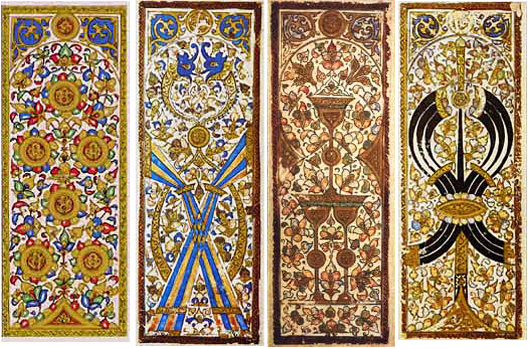The na’ib and the malik of the Islamic suit begot the viceroy and the king in the Spanish card deck. The na’ib thani yielded the squire. The original Islamic cards did not carry the images of the characters in the deck. The Spanish sword emerged from the Arab scimitar and the cudgel from the shepherd staff. The cup and the coin did not change; socialising drinks and trade were the common currency of Islamic and Christian Mediterranean cultures. One distinct peculiarity of the Islamic deck is that the knights and kings appeared as names in classical Arabic calligraphy, not human representations.
Mamluk playing cards
Mamluk playing cards, c.1500. From left to right: six of coins, ten of sticks, three of cups (called myriads) and seven of swords (Topkapı Palace Museum, Istanbul; public domain).
Jorge Cañizares-Esguerra
Further reading
- Cashner, A.A. (2014) ‘Playing cards at the eucharistic table: Music, theology, and society in a Corpus Christi Villancico from colonial Mexico, 1628’, Journal of Early Modern History, 18: 383–419.
- de Covarrubias, P. (1543) Remedio de jugadores (Barcelona).
- Fajardo, F.L. (1603) Fiel Desengaño contra la ociosidad y los juegos: utilisisimo a los confesores, penitentes y justicias y demás a cuyo cargo está limpiar de vagabundos, tahúres y fulleros la Republica Cristiana (Madrid).





